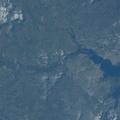
WIKIARCHIVES.SPACE
The Human Spaceflight Archive

This image shows fresh boulders on the inner ring of Hertzsprung basin, thought to be nearly pure anorthosite. LROC's narrow angle camera image focuses in on the Hertzsprung Constellation region of interest detailing a portion of the inner ring (270 km or 168 miles diameter) of Hertzsprung basin (570 km or 354 miles diameter) on the lunar far side. This basin is of Nectarian age (ancient) and is intermediate in size between two-ring basins (e.g., Schrodinger) and larger, multi-ring basins (e.g., Orientale). As such, it excavates material from an intermediate depth that helps us better understand the composition and structure of different zones of the lunar crust. LROC NAC image M112421089RE. Image is approximately 690 meters or 755 yards across and the Sun is from the right of the frame (east).
Information
- Taken in
- Author
- NASA/GSFC/Arizona State University
- Description
-
This image shows fresh boulders on the inner ring of Hertzsprung basin, thought to be nearly pure anorthosite. LROC's narrow angle camera image focuses in on the Hertzsprung Constellation region of interest detailing a portion of the inner ring (270 km or 168 miles diameter) of Hertzsprung basin (570 km or 354 miles diameter) on the lunar far side. This basin is of Nectarian age (ancient) and is intermediate in size between two-ring basins (e.g., Schrodinger) and larger, multi-ring basins (e.g., Orientale). As such, it excavates material from an intermediate depth that helps us better understand the composition and structure of different zones of the lunar crust. LROC NAC image M112421089RE. Image is approximately 690 meters or 755 yards across and the Sun is from the right of the frame (east).
NASA's Goddard Space Flight Center built and manages the mission for the Exploration Systems Mission Directorate at NASA Headquarters in Washington. The Lunar Reconnaissance Orbiter Camera was designed to acquire data for landing site certification and to conduct polar illumination studies and global mapping. Operated by Arizona State University, LROC consists of a pair of narrow-angle cameras (NAC) and a single wide-angle camera (WAC). The mission is expected to return over 70 terabytes of image data.
- Created on
- Tuesday 25 May 2010
- Albums
- US SPACE PROGRAM / PROBES / MOON / LRO/LCROSS / Mission Photos (Edited)
- Source link
- https://photojournal.jpl.nasa.gov
- Visits
- 18
- Rating score
- no rate
- Rate this photo
- License
- Public Domain
- Modified by WikiArchives
- No (original)
- Downloads
- 0
Powered by Piwigo






































































































































































































































































































































































































































































